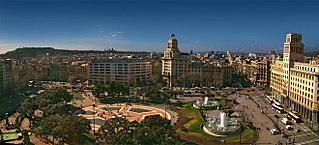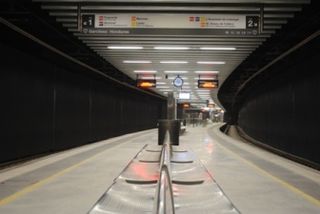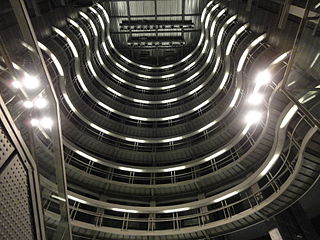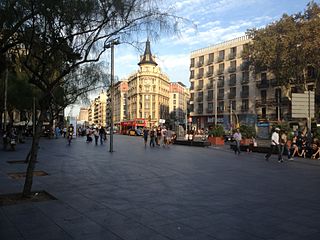
The Barcelona Metro is a network of rapid transit electrified railway lines that run mostly underground in central Barcelona and into the city's suburbs. It is part of the larger public transport system of Barcelona, the capital of Catalonia, Spain, with unified fares under the Autoritat del Transport Metropolità (ATM) scheme. As of 2014, the network is operated by two separate companies: Transports Metropolitans de Barcelona (TMB) and Ferrocarrils de la Generalitat de Catalunya (FGC). It is made up of 12 lines, combining the lines owned by the two companies. Two lines, L9 and L10, are being built at present, with both lines having different sections of each opened between 2009 and 2018. They are due to be fully completed in 2026. Three lines on the network have opened as automatic train operation/driverless vehicle systems since 2009: Line 11 being converted to driverless first, and then Lines 9 and 10, opening up driverless.

The Trambaix is one of Barcelona's three tram systems. It is operated by TRAMMET connecting the Baix Llobregat area with the city of Barcelona, Catalonia, Spain. It opened to the public on 5 April 2004 after a weekend when the tram could be used free of charge.
The IBM 728 was an IBM 7 series magnetic tape drive. It was used on the SAGE AN/FSQ-7 computer. It was physically similar to the IBM 727, but with significantly different specifications.
Contra dance form describes the arrangement of dancers into contra dance sets and minor sets. There are various forms, and each dance's choreography specifies its formation. A caller's first instructions for each dance are usually to move the dancers into their starting positions according to the choreography for that dance.

Gran Via de les Corts Catalanes, more simply known as Gran Via, is one of Barcelona's major avenues. With a length of 13.1 km (8.1 mi), it is the longest street in Catalonia and the 2nd longest in Spain, after Gran Vía de la Manga, in La Manga del Mar Menor, but is the one with most street numbers in Spain.

Line 5, currently known as Cornellà Centre – Vall d'Hebron, its termini, and often called "Línia Blava", is a rapid transit metro line belonging to the Barcelona Metro network operated by TMB, and part of the ATM fare-integrated transport network.

Line 9 is a completely automated line of the Barcelona Metro network that is currently under construction, with 24 stations open in Barcelona and El Prat de Llobregat, L'Hospitalet de Llobregat, Badalona and Santa Coloma de Gramenet suburbs, since December 2009. The line is currently disconnected in two branches, with a connecting part between the two yet to be built. The Aeroport T1 – Zona Universitària section is called L9 South, and the La Sagrera – Can Zam portion L9 North. Upon completion, it will be the longest underground metro line in Europe.
Line 8, coloured pink and operated by FGC, is part of the Barcelona Metro network, and therefore of the larger ATM fare-integrated transport system. It joins Plaça Espanya, in the Sants-Montjuïc district of Barcelona with metropolitan area municipalities of L'Hospitalet de Llobregat, Cornellà de Llobregat and Sant Boi de Llobregat.

Avinguda Diagonal is the name of one of Barcelona's broadest and most important avenues. It cuts the city in two, diagonally with respect to the grid pattern of the surrounding streets, hence the name.

Plaça de Catalunya is a large square in central Barcelona that is generally considered to be both its city centre and the place where the old city and the 19th century-built Eixample meet.

Provença is the name of a Ferrocarrils de la Generalitat de Catalunya station located under Avinguda Diagonal and Balmes street. The station is served by FGC-operated Barcelona Metro lines L6 and L7, and Metro del Vallès suburban metro lines S1 and S2. Diagonal is the name of an important station in TMB-operated Barcelona Metro network. It is named after Avinguda Diagonal, where the station is located together with Passeig de Gràcia. It is served by TMB-operated Barcelona Metro lines L3 and L5, and it is also connected with FGC station.

Passeig de Sant Joan is a major avenue in the Eixample and Gràcia districts of Barcelona. It was named after an older street carrying this name, also known as Passeig Nou, built in 1795 around the glacis of the Ciutadella fortress.

Zona Universitària is a station in the Barcelona Metro and Trambaix networks, in the Les Corts district of Barcelona. It is currently the western terminus of metro line L3 and L9. Also it's served by tram lines T1, T2 and T3. It is named after the Universitat de Barcelona campus of the same name.

La Sagrera-Meridiana, simply known as La Sagrera, is an interchange complex underneath Avinguda Meridiana, in the Barcelona district of Sant Andreu, in Catalonia, Spain. It consists of a Rodalies de Catalunya station and three Barcelona Metro stations. The Rodalies de Catalunya station is located in the Meridiana Tunnel on the Lleida to Barcelona via Manresa railway, between Sant Andreu Arenal and Arc de Triomf, and is operated by Renfe Operadora. It is served by Barcelona commuter rail service lines R3 and R4, as well as regional rail line R12. The Barcelona Metro stations are on lines 1 (L1) and 5 (L5), as well as the northern section of line 9/10, and are operated by Transports Metropolitans de Barcelona (TMB). On the L1, the station is between Navas and Fabra i Puig, on the L5 between Camp de l'Arpa and Congrés, and on the L9/L10 between Plaça Maragall (future) and Sagrera - TAV. The station is also projected to become the terminus of the L4 once the extension from La Pau opens. A number of interurban bus services stop near the station.

Avinguda Meridiana is a major avenue in Barcelona, Catalonia, Spain, spanning parts of the Sant Andreu, Nou Barris and Sant Martí northern districts of the city. Originally planned by Ildefons Cerdà in 1859 to be one of the two most important thoroughfares in Barcelona, its actual role has not been exactly so but still has become a much transited route linking Parc de la Ciutadella with northern parts of Barcelona, crossing Plaça de les Glòries in its way, where it meets other two major avenues: Gran Via de les Corts Catalanes and Avinguda Diagonal. It absorbs the traffic coming from the AP-7 motorway, which makes it a densely transited area. The avenue goes through the following neighbourhoods of Barcelona: El Clot, Navas, La Sagrera, Sant Andreu de Palomar, El Congrés i els Indians, Vilapicina, Porta, La Prosperitat, La Trinitat Nova, Trinitat Vella and Vallbona, largely working-class areas of the city.

Line 10 is the name of one of the two branches of the Barcelona metro line 9, currently (2020) under construction and to be operated by TMB. Like Line 9 and Line 11, it will be an automatic train operation metro line.

Gràcia is a railway station located under Plaça de Gal·la Placídia in the Gràcia district of Barcelona. It is served both by lines L6 and L7 of the Barcelona Metro, and by lines S1 and S2 of the Metro del Vallès commuter rail system. All these lines are operated by Ferrocarrils de la Generalitat de Catalunya, who also run the station.

Rail transport in Catalonia operates on three rail gauges and services are operated by a variety of public operators:

Ronda de la Universitat is a major thoroughfare of central Barcelona, Catalonia, Spain, in lower side of the Dreta de l'Eixample, in the Eixample district. It links two of the city's three main squares, running from Plaça de Catalunya towards Plaça Universitat. There it meets Gran Via de les Corts Catalanes and Ronda de Sant Antoni begins. It's essentially the same street as Ronda de Sant Pere, which follows it right after Plaça de Catalunya. As the other ronda, it follows the original outline of the medieval city walls, particularly the wall of Tallers, above the area nowadays known as Raval, where a road called Carrer de Tallers runs partially parallel to it. Ronda de la Universitat was paved in 1872. It takes its name from the Universitat de Barcelona, which has had its main building at Plaça Universitat since the 19th century. Before its current name was approved in 1989, its official name was in Spanish: Universidad. The Biblioteca Judicial de Catalunya is on this street.

Francesc Macià is a Trambaix station and a projected metro station located in the Plaça de Francesc Macià, Barcelona, crossed by the Avinguda Diagonal, in the Sarrià-Sant Gervasi district. This stop is the terminal for the three Trambaix routes.

















